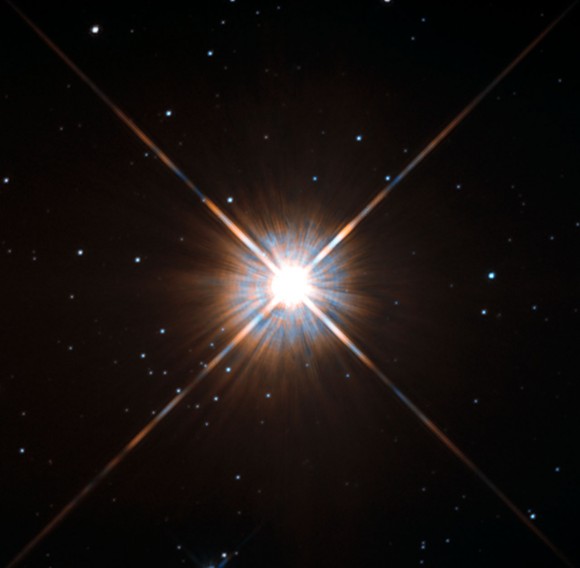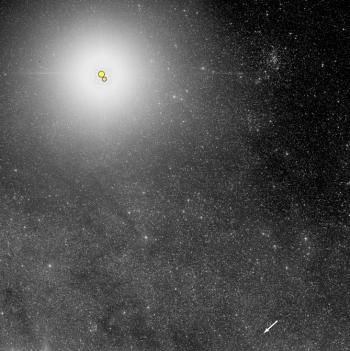
Hubble Space Telescope image of Proxima Centauri, the closest known star to the sun. Read more about this image. Image via ESA/Hubble & NASA.
The star Proxima Centauri isn’t visible to the eye, but it’s one of the most noted stars in Earth’s sky. That’s because it is considered to be part of the Alpha Centauri star system, a triple system, and the nearest star system to our sun. Of the three stars in Alpha Centauri, Proxima is thought to be the one actually closest to our sun, at 4.22 light-years away. The image above – from the Hubble Space Telescope – is one of the best we’ve seen at showing Proxima clearly.
If it’s so nearby, why can’t we see Proxima Centauri with the eye? It’s because Proxima is so small. It’s a red dwarf star with only about an eighth of the mass of the sun. Faint red Proxima Centauri – at only 3,100 degrees K (5,120 F) and 500 times less bright than our sun – is nearly a fifth of a light-year from Alpha Centauri A and B.
This great distance from the two primary stars in the system is what calls into question its status as part of a triple star system.
On the other hand, although Proxima is far from Alpha Centauri A and B, it is not very far from us. And thus – over time – we can see its motion through space.

Alpha Centauri A and B are a double-star system, and a third star, Proxima – whose location with respect to the other two is indicated here by an arrow – might or might not be gravitationally bound to them. Proxima is the closest star to Earth. Image via the European Southern Observatory.
In 2016, the European Southern Observatory announced the discovery of Proxima b, a planet orbiting Proxima Centauri at a distance of roughly 7.5 million km (4.7 million miles) with an orbital period of approximately 11.2 Earth days. Its estimated mass is at least 1.3 times that of the Earth. The equilibrium temperature of Proxima b is estimated to be within the range of where water could exist as liquid on its surface, thus placing it within the habitable zone of Proxima Centauri. But a 2017 study suggests that the exoplanet does not have an Earth-like atmosphere. That may indicate that radiation from its star would drain an Earth-like atmosphere 10,000 times faster than on Earth, although because Proxima Centauri is a red dwarf and a flare star, whether it could support life is disputed. Previous searches for orbiting companions had ruled out the presence of brown dwarfs and supermassive planets.
Bottom line: Proxima Centauri, one of three stars in the Alpha Centauri system, is the nearest star to our sun. It’s 4.22 light-years away.
Enjoying EarthSky so far? Sign up for our free daily newsletter today!
from EarthSky https://ift.tt/2OLGI2Q

Hubble Space Telescope image of Proxima Centauri, the closest known star to the sun. Read more about this image. Image via ESA/Hubble & NASA.
The star Proxima Centauri isn’t visible to the eye, but it’s one of the most noted stars in Earth’s sky. That’s because it is considered to be part of the Alpha Centauri star system, a triple system, and the nearest star system to our sun. Of the three stars in Alpha Centauri, Proxima is thought to be the one actually closest to our sun, at 4.22 light-years away. The image above – from the Hubble Space Telescope – is one of the best we’ve seen at showing Proxima clearly.
If it’s so nearby, why can’t we see Proxima Centauri with the eye? It’s because Proxima is so small. It’s a red dwarf star with only about an eighth of the mass of the sun. Faint red Proxima Centauri – at only 3,100 degrees K (5,120 F) and 500 times less bright than our sun – is nearly a fifth of a light-year from Alpha Centauri A and B.
This great distance from the two primary stars in the system is what calls into question its status as part of a triple star system.
On the other hand, although Proxima is far from Alpha Centauri A and B, it is not very far from us. And thus – over time – we can see its motion through space.

Alpha Centauri A and B are a double-star system, and a third star, Proxima – whose location with respect to the other two is indicated here by an arrow – might or might not be gravitationally bound to them. Proxima is the closest star to Earth. Image via the European Southern Observatory.
In 2016, the European Southern Observatory announced the discovery of Proxima b, a planet orbiting Proxima Centauri at a distance of roughly 7.5 million km (4.7 million miles) with an orbital period of approximately 11.2 Earth days. Its estimated mass is at least 1.3 times that of the Earth. The equilibrium temperature of Proxima b is estimated to be within the range of where water could exist as liquid on its surface, thus placing it within the habitable zone of Proxima Centauri. But a 2017 study suggests that the exoplanet does not have an Earth-like atmosphere. That may indicate that radiation from its star would drain an Earth-like atmosphere 10,000 times faster than on Earth, although because Proxima Centauri is a red dwarf and a flare star, whether it could support life is disputed. Previous searches for orbiting companions had ruled out the presence of brown dwarfs and supermassive planets.
Bottom line: Proxima Centauri, one of three stars in the Alpha Centauri system, is the nearest star to our sun. It’s 4.22 light-years away.
Enjoying EarthSky so far? Sign up for our free daily newsletter today!
from EarthSky https://ift.tt/2OLGI2Q

Aucun commentaire:
Enregistrer un commentaire